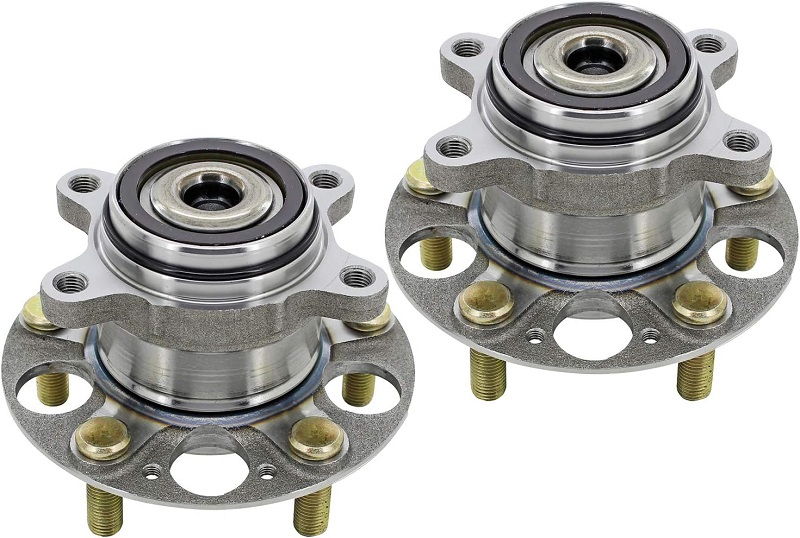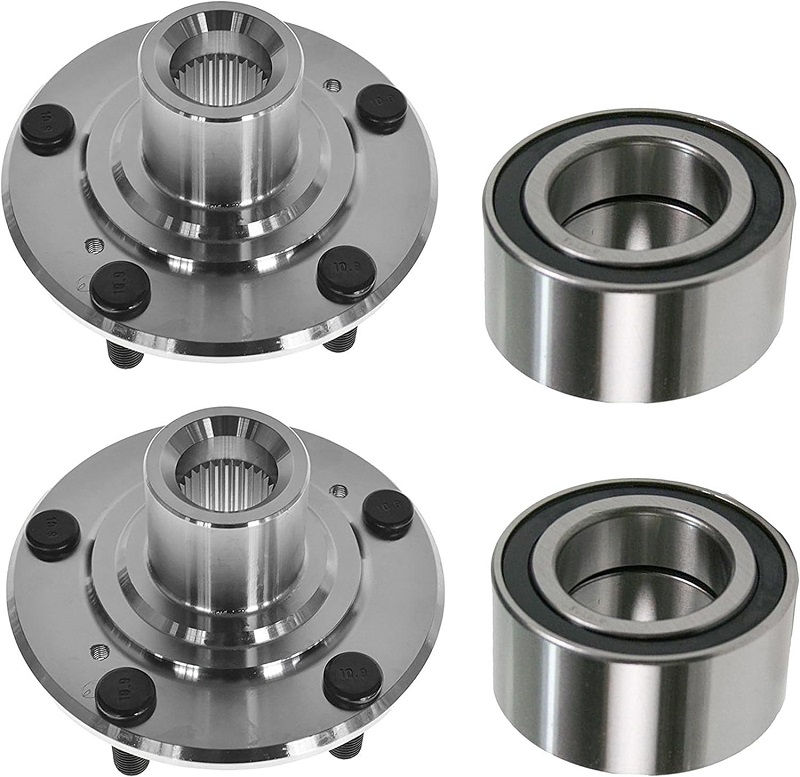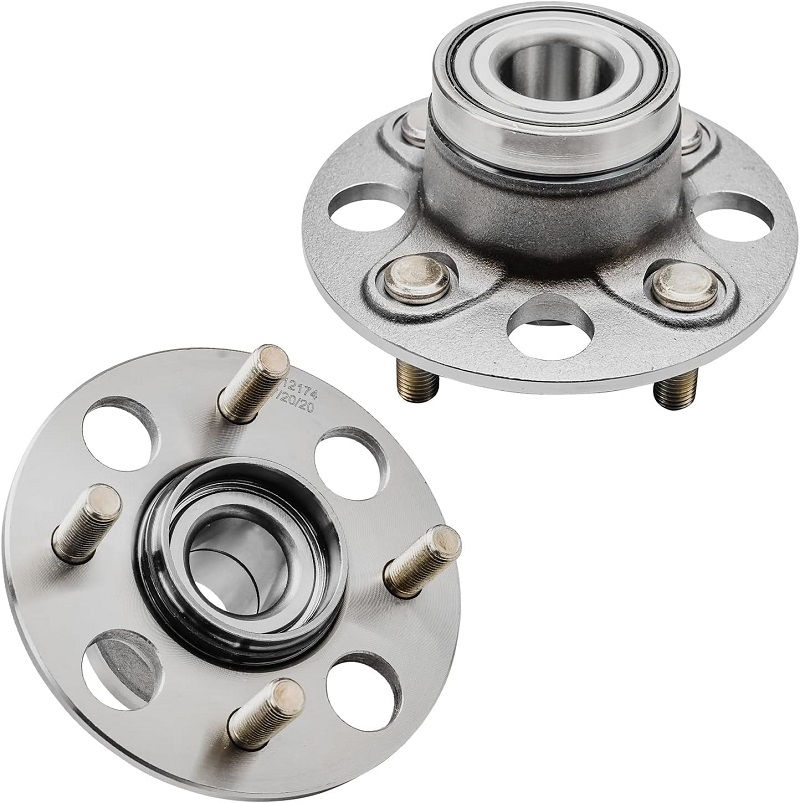This post contains affiliate links. This means I will make a commission at no extra cost to you should you click through and make a purchase [ “As an Amazon Associate, I earn from qualifying purchases.” ]. Read the full disclosure here.
Honda Civic Wheel Bearing GuideMechanic.Com Are you experiencing strange noises or vibrations coming from your Honda Civic’s wheels? It could be a sign of a failing wheel bearing.
The wheel bearings play a crucial role in the smooth operation of your vehicle, providing support and reducing friction between the wheel and the axle.
In this comprehensive guide, we will delve into the world of Honda Civic wheel bearings, exploring their function, signs of failure, maintenance tips, and even the process of replacing them.
Whether you are a car enthusiast or a Honda Civic owner, this article will equip you with all the knowledge you need to keep your wheels rolling smoothly.
Honda Civic Wheel Bearing: What Are Wheel Bearings?
Check out this Rear Wheel Bearing and Hub Assembly for 2012-2015 Honda Civic 1.5 1.8L L4 FWD SOHC Part# WA512450

Wheel bearings are a set of small steel balls or rollers housed in a metal ring called a race. They are located inside the hub assembly of your Honda Civic’s wheels and are responsible for reducing friction and supporting the weight of the vehicle. The primary function of wheel bearings is to enable smooth rotation of the wheels by allowing them to spin freely on the axle.
There are two main types of wheel bearings used in vehicles: ball bearings and roller bearings. Ball bearings consist of small metal balls held in place by a cage, while roller bearings use cylindrical or tapered rollers. Both types of bearings have their own advantages and are chosen based on the specific requirements of the vehicle.
The Purpose of Wheel Bearings
The purpose of wheel bearings is to withstand the weight of the vehicle and provide a low-friction surface for the wheel to rotate on.
See Also: Honda Accord 2007 Catalytic Converter
They help maintain proper alignment of the wheel and prevent excessive wear on the tires. Additionally, wheel bearings contribute to the overall stability and handling of the vehicle, ensuring a smooth and comfortable ride.
Different Types of Wheel Bearings
Ball Bearings: Ball bearings are the most commonly used type of wheel bearings in vehicles. They consist of small steel balls arranged in a circular pattern and separated by a cage. Ball bearings offer low friction, high load-carrying capacity, and are suitable for both radial and axial loads.
Roller Bearings: Roller bearings, on the other hand, use cylindrical or tapered rollers instead of balls. They provide higher load-carrying capacity and are better suited for heavy-duty applications. Roller bearings are commonly used in larger vehicles or those that carry heavy loads.
Sealed Bearings: Sealed wheel bearings are a type of bearing that comes pre-greased and sealed, providing better protection against contaminants and moisture. They require less maintenance and are often used in vehicles that are exposed to harsh conditions.
Honda Civic Wheel Bearing: Signs of Failing Wheel Bearings

Failing wheel bearings can manifest through various signs and symptoms. It’s essential to recognize these indicators early on to prevent further damage and ensure your safety on the road. By being attentive to the following signs, you can address wheel bearing issues promptly:
Unusual Noises
One of the most common signs of failing wheel bearings is unusual noises coming from the wheels. These noises can range from a humming or rumbling sound to a growling or grinding noise.
The noise is typically more prominent when you’re driving at higher speeds or when taking turns. Pay close attention to any new or unusual sounds, as they could indicate a problem with your wheel bearings.
Vibrations
Another noticeable sign of failing wheel bearings is vibrations felt through the steering wheel or the floor of the vehicle. These vibrations can vary in intensity and may become more pronounced as the condition of the wheel bearings worsens.
If you experience excessive vibrations, especially at higher speeds, it’s crucial to have your wheel bearings inspected and replaced if necessary.
Uneven Tire Wear
Faulty wheel bearings can lead to uneven tire wear, particularly on the affected wheel. If you notice that one tire is wearing out faster than the others or if you observe abnormal wear patterns such as cupping or feathering, it could be an indication of a failing wheel bearing. Regularly inspecting your tires for signs of uneven wear can help you identify potential wheel bearing issues.
Poor Handling and Steering
Wheel bearings play a vital role in maintaining proper alignment and stability of your vehicle. When they start to fail, you may experience difficulty in steering or notice a loss of control while driving.
If your Honda Civic feels less responsive or exhibits unusual handling characteristics, it’s essential to have your wheel bearings checked by a professional mechanic.
ABS Warning Light
In some cases, a failing wheel bearing can trigger the ABS (Anti-Lock Braking System) warning light on your dashboard. The ABS system relies on information from wheel speed sensors, which can be affected by faulty wheel bearings. If the ABS warning light illuminates, it’s advisable to have your wheel bearings inspected along with the ABS system.
Honda Civic Wheel Bearing: Causes of Wheel Bearing Failure

Wheel bearings are subjected to various factors that can lead to their failure over time. Understanding these causes can help you take proactive measures to prevent premature wear and extend the lifespan of your Honda Civic’s wheel bearings:
Excessive Wear
As with any mechanical component, wheel bearings can wear out over time due to constant use and exposure to road conditions.
See Also: Catalytic Converter Honda CRV 2001
Factors such as mileage, driving habits, and the quality of the bearings can contribute to the rate of wear. Regular maintenance and periodic inspection can help identify worn-out wheel bearings before they cause further damage.
Contamination
Contamination is another common cause of wheel bearing failure. Dust, dirt, water, and other foreign particles can enter the bearing and compromise its smooth operation.
Contaminated bearings may experience increased friction, overheating, and accelerated wear. Regular cleaning and proper sealing can help prevent contamination and extend the life of your wheel bearings.
Improper Installation
Improper installation of wheel bearings can lead to premature failure. If the bearings are not installed correctly or if the recommended torque specifications are not followed during installation, it can result in excessive play or improper alignment. It’s crucial to have wheel bearings installed by a qualified technician or follow the manufacturer’s guidelines for DIY installations.
Overloading and Hard Driving
Excessive loads, aggressive driving, and harsh road conditions can put additional stress on your Honda Civic’s wheel bearings.
Overloading your vehicle beyond its recommended capacity or frequently engaging in activities such as towing or off-roading can accelerate wear and increase the chances of wheel bearing failure. Practice responsible driving habits and avoid unnecessary strain on your vehicle’s components.
Lack of Lubrication
Proper lubrication is essential for the smooth operation and longevity of wheel bearings. Insufficient or contaminated lubricant can result in increased friction, heat buildup, and premature wear of the bearings.
Regularly checking and replenishing the lubricant, as recommended by your vehicle’s manufacturer, can help prevent dry or inadequate lubrication.
Checking and Maintaining Wheel Bearings
To ensure optimal performance and longevity of your Honda Civic’s wheel bearings, regular inspection and maintenance are crucial.
Performing routine checks can help identify early signs of wear or damage and allow you to take appropriate action. Here are some steps you can follow to check and maintain your wheel bearings:
Visual Inspection
Start by visually inspecting your Honda Civic’s wheel bearings for any signs of damage or wear. Look for loose or missing parts, corrosion, leaks, or excessive play in the wheel.
Inspect the seals for any signs of damage or leaks as well. If you notice any abnormalities during the visual inspection, it’s advisable to have your vehicle inspected by a professional mechanic.
Listening for Unusual Noises
While driving, pay close attention to any unusual noises coming from the wheels. Any grinding, rumbling, or humming sounds can indicate a problem with the wheel bearings.
See Also: 2006 Honda CRV Catalytic Converter
These noises are often more noticeable at higher speeds or when taking turns. If you hear any abnormal sounds, it’s essential to have your wheel bearings inspected as soon as possible.
Checking for Wheel Play
Wheel play refers to the amount of movement or play in the wheel when it is jiggled or rocked back and forth. Excessive wheel play can be an indication of a worn-out wheel bearing.
Jack up your Honda Civic’s wheel, grab it at the top and bottom, and try to move it back and forth. If you notice significant movement or play, it’s recommended to have your wheel bearings inspected and replaced if necessary.
Lubrication and Sealing
Proper lubrication and sealing are vital for the smooth operation of your wheel bearings. Inspect the seals for any signs of damage, leaks, or contamination.
Ensure that the seals are intact and properly seated. Additionally, check the lubricant level and quality. If necessary, clean and repack the wheel bearings with fresh grease according to the manufacturer’s recommendations.
Regular Maintenance Schedule
To maintain the health of your Honda Civic’s wheel bearingsand prevent potential issues, it is important to follow a regular maintenance schedule.
Consult your vehicle’s owner manual or the manufacturer’s recommendations for the specific maintenance intervals for your wheel bearings.
Regular maintenance may include cleaning, lubricating, and inspecting the bearings for wear or damage. By adhering to a maintenance schedule, you can catch any potential problems early on and address them before they turn into major issues.
Replacing Wheel Bearings in a Honda Civic
If your wheel bearings are beyond repair or have reached the end of their service life, it is crucial to replace them promptly to ensure the safety and performance of your Honda Civic.
While wheel bearing replacement can be a complex task, following the correct procedures and using the right tools can make the process more manageable. Here is a step-by-step guide on how to replace wheel bearings in your Honda Civic:
Gather the Necessary Tools
Before beginning the replacement process, gather all the tools you will need. This may include a jack, jack stands, lug wrench, socket set, torque wrench, bearing puller, grease, and new wheel bearings. Make sure you have the correct size and type of bearings for your Honda Civic model and year.
Lift and Secure the Vehicle
Start by safely lifting your Honda Civic off the ground using a jack and supporting it with jack stands. Ensure that the vehicle is stable and secure before proceeding with the wheel bearing replacement.
Remove the Wheel and Brake Components
Remove the wheel by using a lug wrench to loosen and remove the lug nuts. Set the wheel aside in a safe place. Next, disassemble the brake components, including the caliper and rotor, following the manufacturer’s instructions. Be careful not to damage any brake lines or components during this process.
Remove the Old Wheel Bearings
Once the brake components are removed, you can access the wheel bearings. Depending on the design of your Honda Civic’s hub assembly, you may need to remove the hub or hub assembly to access the bearings. Use the appropriate tools, such as a bearing puller or press, to carefully remove the old bearings from the hub.
Clean and Inspect the Hub Assembly
With the old bearings removed, thoroughly clean the hub assembly using a suitable solvent and a clean cloth. Inspect the hub for any signs of damage, wear, or corrosion. If the hub shows any signs of damage, it is advisable to replace it along with the wheel bearings.
Install the New Wheel Bearings
Apply a thin layer of fresh grease to the surfaces of the new wheel bearings. Carefully insert the new bearings into the hub assembly, ensuring they are properly seated.
See Also: 2007 Honda CRV Alternator
Consult the manufacturer’s instructions or a professional mechanic for the correct installation procedure specific to your Honda Civic model.
Reassemble the Brake Components
Once the new wheel bearings are installed, reassemble the brake components in the reverse order of removal. Follow the manufacturer’s instructions or consult a professional mechanic to ensure proper reassembly. Pay attention to torque specifications and any recommended procedures for brake caliper alignment or bleeding.
Mount the Wheel and Lower the Vehicle
Mount the wheel back onto the hub and tighten the lug nuts using a lug wrench. Lower your Honda Civic from the jack stands by carefully lowering the jack. Once the vehicle is on the ground, use a torque wrench to properly tighten the lug nuts to the manufacturer’s specifications.
Test and Verify
After replacing the wheel bearings, take your Honda Civic for a test drive to ensure that everything is functioning correctly. Pay attention to any unusual noises, vibrations, or handling issues. If you notice any abnormalities, it is advisable to have your vehicle inspected by a professional mechanic as soon as possible.
Tips for Extending the Lifespan of Wheel Bearings
While wheel bearings are subject to wear and tear over time, following these tips can help extend their lifespan and maintain their optimal performance:
Practice Responsible Driving Habits
Avoid aggressive driving, excessive speeds, and sudden stops or starts. These actions can put unnecessary strain on your Honda Civic’s wheel bearings and accelerate wear. Practice responsible driving habits and maintain a smooth and consistent driving style.
Avoid Overloading Your Vehicle
Adhere to the recommended weight limits for your Honda Civic and avoid overloading it beyond its capacity. Excessive weight can put additional stress on your wheel bearings and other components, leading to premature wear and potential failure.
Regularly Inspect and Maintain Your Wheel Bearings
Perform routine visual inspections of your wheel bearings and check for any signs of damage, wear, or contamination. Clean and lubricate the bearings as recommended by the manufacturer or a professional mechanic. Regular maintenance can help detect issues early and prevent further damage.
Avoid Driving through Deep Water or Potholes
Driving through deep water or hitting potholes can expose your wheel bearings to excessive moisture, contaminants, and impact forces. Whenever possible, avoid such conditions to minimize the risk of damage to your wheel bearings and other suspension components.
Follow the Manufacturer’s Maintenance Schedule
Consult your Honda Civic’s owner manual or the manufacturer’s recommendations for the specific maintenance intervals for your wheel bearings.
Adhering to the recommended maintenance schedule, including cleaning, lubricating, and inspecting the bearings, can help identify and address any potential issues before they worsen.
See Also: 2001 Honda Accord Catalytic Converter
- Small Food Trucks for Sale - July 6, 2025
- Turnkey Food Trucks for Sale in California - July 6, 2025
- Mobile Food Trucks for Sale in Texas - July 6, 2025
